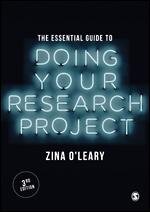10 Steps to Demystify the Research Process
[su_heading style="default" size="13" align="center" margin="20" class=""]MentorSpace: The How of Methods[/su_heading] [su_dropcap style="default" size="3" class=""]T[/su_dropcap]here is no doubt that research can be an intimidating process. There are so many decisions to make; so many paths you can go down. And all the theories, perspectives, paradigms, methodologies, and methods can seem complex and confusing. But I can tell you what research always is, and that’s logical. And understanding this logic is the best way to prevent yourself from becoming lost in the process.For me, the logic manifests as a journey that takes the following path:
[su_dropcap style="default" size="3" class=""]T[/su_dropcap]here is no doubt that research can be an intimidating process. There are so many decisions to make; so many paths you can go down. And all the theories, perspectives, paradigms, methodologies, and methods can seem complex and confusing. But I can tell you what research always is, and that’s logical. And understanding this logic is the best way to prevent yourself from becoming lost in the process.For me, the logic manifests as a journey that takes the following path:
- Curiosity | This is what you’re interested in; what you have wondering about and what you most want to understand; from asking how things work, questioning why they don’t to searching for ways they can be better, curiosity is how the research process starts.
- Question development | Once you hone in on your interests it is time to nail your research question. Remember, research is the process of designing and implementing a plan for answering your research question so if you have a topic, but are not sure of the question, you simply cannot design a way to get appropriate answers.
- Understanding the state of play | Now that you have articulated what it is you want to know in the form of a research question, you need to find out what other researchers have already discovered in and around your topic. After all, you’re unlikely to be uncovering a whole new field, and instead will be adding to an existing body of knowledge, something you cannot not do well if you’re not in the know.
- Revise/ hone in | Step 3 will help you hone in on the contribution that your research will make to your field. This needs to be captured in the re-evaluation and articulation of your research question.
 Deciding who has / where the answers are | Once you have a honed-in, well-articulated research question, it is time to think about where the answer to your question lies. Who has the answer? Does it reside with a population; a key informant; a community; a panel of experts; in documents; on the web; in existing records? Locating sources for answers is the first step to defining method.
Deciding who has / where the answers are | Once you have a honed-in, well-articulated research question, it is time to think about where the answer to your question lies. Who has the answer? Does it reside with a population; a key informant; a community; a panel of experts; in documents; on the web; in existing records? Locating sources for answers is the first step to defining method.- Deciding how to collect your data | Deciding on appropriate and ethical methods becomes a lot easier when you know where the answers lie. If you think about it logically, if your answers are with an expert – you will need to interview; if your answers are in existing records- you will need to do secondary analysis; if they are in document - you will do document analysis; if they are with community - you are likely to do a survey. Of course, a combination of the above is also a likely possibility.
- Getting you data together | Data collection, finally! Get conducting your interviews; administering your survey; trolling through the documents etc.
- Making sense of what you find | The analysis. Statistics for the quantitative data and thematic analysis for the qualitative data. Think of this as an ongoing process as your data comes in. It is a process of assessing your data and its meaning in relation to your research question at every turn.
- Sharing insights | Look for the meaning that sits in the words, numbers, and images you have collected. You are trying to develop a narrative here that captures and shares your insights in a meaningful way; first in your discussion and then in your eventuating conclusion.
- Offering recommendations | Most research arises from concerns - whether it is in a workplace, community, or political system, most of our research illuminates problems, offers solutions, or evaluates attempts at situation improvement. This means we have the opportunity to move our findings to recommendations and steps for action that can help in evidence based decision making.
That’s it - 10 logical steps that hopefully demystify the research process or at least ease some trepidation.
